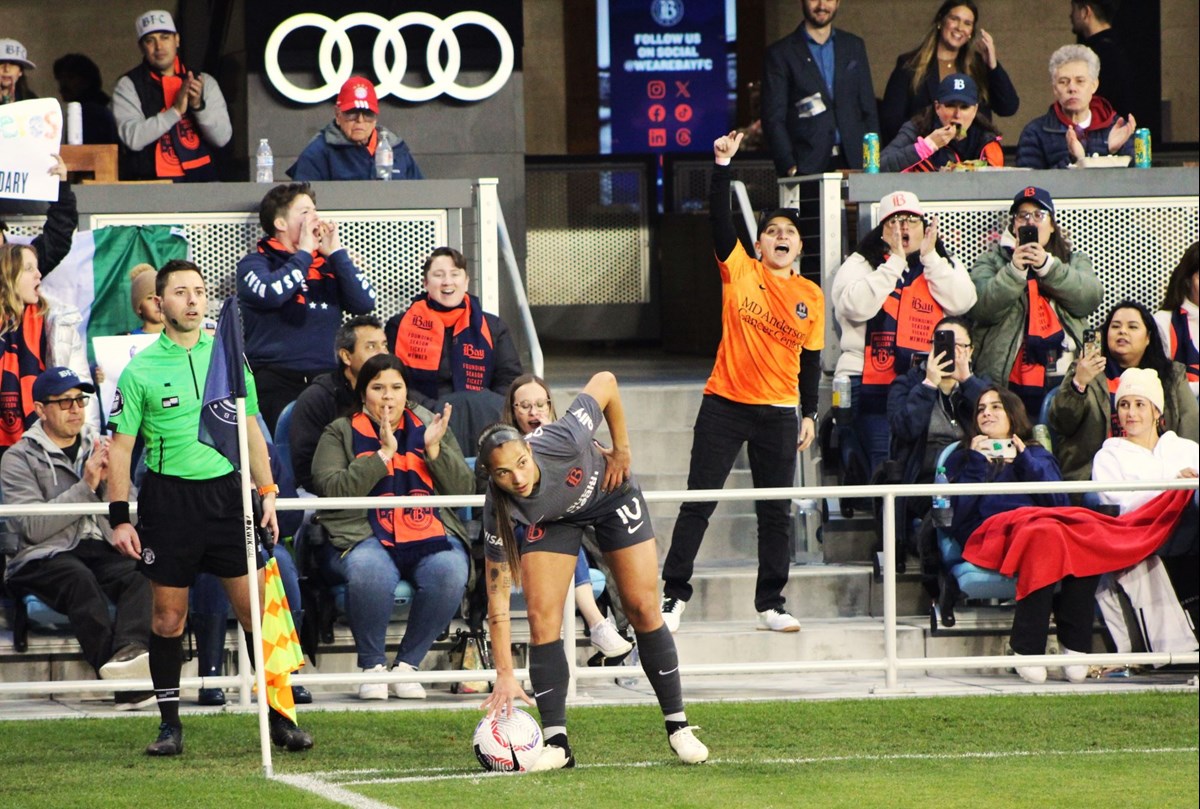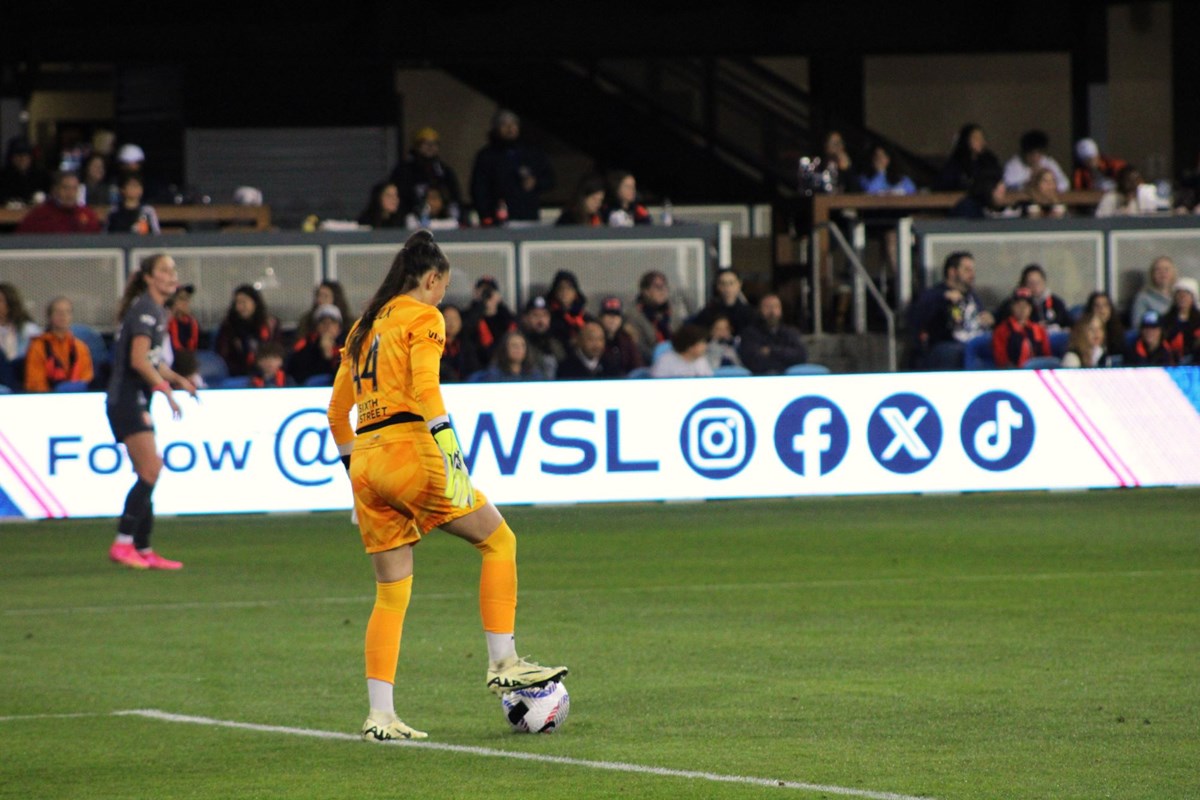At Bay FC’s sold-out inaugural home game, the team was already making history.
At the March 30 game, a Bay FC spokesperson said the stands were packed with around 18,000 fans in attendance, making it the largest crowd to attend a women’s professional sporting event in the Bay Area. The spokesperson said the previous record was held by the San Jose CyberRays, a women’s professional soccer team that brought in a crowd of 16,174 for a game all the way back in 2001.
But making history is kind of a normal part of women’s soccer these days. For the last few years, the National Women’s Soccer League has annually reported record-breaking audience attendance. This support has allowed the league to add on more franchises, like Bay FC.
It’s a surreal reality for Joelle Anderson, a midfielder for Bay FC. She grew up in the Bay, just a short drive away from San Jose State’s training facility, where she now practices with her team.
“My house I grew up in is 10 minutes down the road,” she said before a practice in March. “Even driving to practice, I’m like wow, I'm just so familiar with all my surroundings. It’s just, like, that sense of home, you know? It just makes it so much better being on this team.”
Anderson grew up attending games for the San Jose Earthquakes, the men’s professional soccer team in the area. She’d started playing soccer herself as a kid and always dreamed of going pro, but she knew it would be difficult.
She had role models in the sport, like Mia Hamm and Abby Wambach, but she also saw that opportunities for players like herself were limited. Both women’s professional soccer teams to ever previously exist in the Bay Area — the San Jose CyberRays and FC Gold Pride — folded after only a couple years of existence. Even finding a TV channel streaming a women’s soccer match could be difficult.
“I can't even imagine what young girls are feeling right now, being able to come to our games and just seeing that packed stadium,” Anderson said. “I would have been over the moon to have a professional team so close to home.”
Finding the right direction
It’s been a long road to get to this point in women’s soccer in the United States. Before the NWSL launched its first season in 2013, there was the Women’s Professional Soccer league, which shuttered in 2012. Before that, there was the short-lived Women’s United Soccer Association in the early 2000s.
“The league and its growth has been up and down. It's never linear,” said Molly Poletto, an assistant coach for women’s soccer at UCLA. “But now I feel it's finally at a place where things are going in the right direction from the resources to the fans, the media, which is exciting.”
Poletto has worked as a coach at the collegiate level for just over a decade. When she started her career, she said it was much harder for women in the U.S. to go pro if they wanted to stay in the country.
“Especially when the league folded, it was like, if you want to play professionally, you have to go overseas,” she said. “And now with the NWSL … they're making the case of [staying] home.”
 Deyna Castellanos, a midfielder for Bay FC, during the team’s inaugural home game at PayPal Park in San Jose on March 30. She scored the first goal of the game.Manola Secaira/CapRadio
Deyna Castellanos, a midfielder for Bay FC, during the team’s inaugural home game at PayPal Park in San Jose on March 30. She scored the first goal of the game.Manola Secaira/CapRadio
Katelyn Rowland, a Bay FC goalkeeper and a UCLA alum, experienced those ups and downs up close. She was in college when the league preceding the NWSL, Women’s Professional Soccer, folded. Up until that moment, her life had revolved around going pro.
“I was actually unsure of if there would even be a league when I was done with college and trying to play afterwards,” Rowland said. “It was scary for sure.”
So when the NWSL rose out of the previous league’s ashes, Rowland was all in. She said she was willing to go anywhere to make it happen. She still remembers getting drafted by Kansas City’s team in 2015.
“I remember the morning I woke up, it was like 6 A.M., and I was listening on a computer on this stream that was like, skipping in and out,” Rowland said. “My ear was to the computer speaker, and I was like, I think they called my name? And then I got a call from the head coach at Kansas City shortly after so I knew they drafted me.”
A lot has changed in the sport since then. Over the years, as she moved on from the Kansas City team and played for a variety of others, she’s seen the league take huge strides in its growth.
“These days, the draft is this massive thing on CBS Sports,” she said. “It's a huge production and I think it just speaks volumes of how far the league has come.”
And then there’s the crowd. When Rowland started her career, she said she felt lucky when she saw a few hundred in attendance.
“A lot of stadiums now are close to selling out every game, which is crazy,” she said.
Only up from here
After years of playing professionally, Rowland said she’s finally seeing women’s soccer get the recognition it deserves.
“I feel like when I look back in 10 years, I'm going to not even recognize the league now,” she said. “We’re making massive jumps every year.”
 Lysianne Proulx, a goalkeeper for Bay FC, during the team’s inaugural home game at PayPal Park in San Jose on March 30.Manola Secaira/CapRadio
Lysianne Proulx, a goalkeeper for Bay FC, during the team’s inaugural home game at PayPal Park in San Jose on March 30.Manola Secaira/CapRadio
As of this year, there are 14 professional women’s soccer teams in the United States with the NWSL promising two more in 2026. When compared to the men’s Major League Soccer, which has a total of 26 teams in the United States, it’s clear there’s room to grow. And now with teams finally getting the support they’ve long sought out, that growth looks possible.
Poletto said she’s hopeful that the league will continue to stay stable in its growth. There’s already been so much important change, like the fact that now players can actually make a living off their job.
“It’s just exciting to see that this is a possibility, that [players] could make a career out of it,” said Poletto. “Whereas I would say early on, you may be offered to go pro but the salary wasn’t livable, and so you’d be having to work multiple jobs and be a player.”
Anderson said she’s also noticed more general awareness of the NWSL’s existence and respect for the sport.
“I've just seen, like, the fan base of women's soccer grow so much in the U.S.,” said Anderson. “If you asked people a few years ago what the NWSL is, they’re like, ‘What’s that?’ So I’ve definitely noticed that more and more people are starting to recognize women's soccer and what we're doing here and I think they're realizing that we're growing something special.”
Bay FC’s part in the story of women’s soccer is only beginning. Although they lost to the Houston Dash at their first home game, they won their following home game in mid-April. They’re scheduled to play a handful of games at their home stadium, PayPal Park, in San Jose throughout the month of May. The season lasts through November.